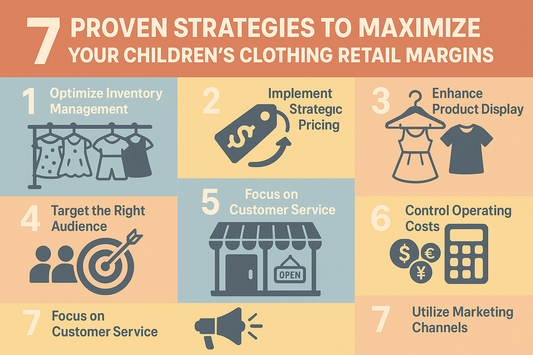
Cómo planificar su inventario estacional: Guía del comprador minorista
Para los minoristas de ropa infantil, dominar la planificación del inventario estacional puede marcar la diferencia entre una rentabilidad próspera y evitar que el exceso de inventario afecte negativamente sus márgenes. Ya sea que gestione una tienda infantil boutique o una empresa minorista mediana en expansión, la planificación estratégica del inventario es fundamental para su éxito. Esta guía completa le guiará a través de enfoques probados para la compra estacional, con especial atención a la gestión de plazos, la previsión de cantidades y la asignación de presupuesto.
Por qué es importante la planificación estacional en el comercio minorista infantil
La venta minorista de ropa infantil presenta desafíos de inventario únicos:
- Etapas de crecimiento rápido que requieren cambios de tamaño frecuentes
- Necesidades estacionales diferenciadas (bañadores, abrigos de invierno, vuelta al cole)
- Fuerte preferencia de los padres por los estilos "nuevos" en lugar de los de la temporada pasada
- Patrones de compra para ocasiones especiales (días festivos, eventos escolares)
Las investigaciones muestran que los minoristas con enfoques de planificación estacional estructurada tienen en promedio un 22 % menos de stock muerto y un 18 % menos de faltantes de stock que aquellos con patrones de compra reactivos.
Creando tu calendario de compras de temporada
Una planificación exitosa del inventario comienza con un calendario de compras bien estructurado que funciona hacia atrás a partir de los períodos de venta clave.
Cronología de compras minoristas de ropa infantil
| Estación | Ventana de compra | Ventana de entrega | Consideraciones clave |
|---|---|---|---|
| Primavera | Sep-Oct | Ene-Feb | Pascua, vacaciones de primavera, clima de transición |
| Verano | Noviembre-diciembre | Mar-Abr | Ropa de vacaciones, actividades de verano, tejidos ligeros. |
| Regreso a la escuela | Febrero-marzo | Junio-julio | Uniformes escolares, básicos de uso diario, transiciones de tallas |
| Caer | Abr-May | Jul-Ago | Capas de prendas, ropa ligera de abrigo, actividades de otoño |
| Día festivo | Mayo-junio | Sep-Oct | Ropa festiva, artículos de regalo, accesorios de invierno. |
| Invierno | Jul-Ago | Octubre-noviembre | Imprescindibles para el frío, conjuntos para las vacaciones, juegos en interiores |
Para los minoristas pequeños y medianos, este cronograma requiere una adaptación en función de su mercado específico, pero el principio sigue siendo: planificar con anticipación, comprar estratégicamente .
Desglose de la planificación mensual
La gestión eficaz del inventario sigue un ciclo continuo:
- 4-6 meses antes de la temporada : Asignación inicial de presupuesto e investigación de tendencias
- 3-4 meses antes de la temporada : Realice pedidos de inventario básico a proveedores establecidos
- 2-3 meses antes de la temporada : pedir artículos según tendencia y configurar sistemas de reposición
- 1-2 meses antes de la temporada : Ajustes finales y pedidos suplementarios de entrega rápida
- Durante la temporada : Análisis semanal de ventas y reposición específica.
Determinación de cantidades óptimas de pedido
Quizás el aspecto más desafiante de la planificación de inventario sea determinar exactamente cuánto comprar. Considere estos enfoques probados:
El método de ajuste de base para minoristas pequeños y medianos
Este enfoque práctico se basa en datos históricos y al mismo tiempo tiene en cuenta el crecimiento y las tendencias:
- Establezca su línea base : revise las ventas del año anterior para la temporada comparable por categoría
- Aplicar factor de crecimiento : Ajústelo a su crecimiento anual proyectado (normalmente entre el 5 % y el 15 % para operaciones minoristas saludables)
- Factor de influencia de la tendencia : aumentar la asignación para las categorías de tendencia, disminuir para las que están en declive
- Equilibrio entre lo esencial y lo moderno : asignar entre el 60 % y el 70 % a artículos esenciales probados y el 30 % al 40 % a piezas de moda que responden a las tendencias.
Ejemplo de cálculo de cantidad
Para una boutique infantil de tamaño mediano que planifica el inventario del otoño de 2025:
- El otoño anterior superó las ventas: 1.200 unidades
- Crecimiento proyectado: 10%
- Cantidad base: 1.320 unidades
- Ajuste de tendencia de categoría: +5% (los tops tienen una fuerte tendencia)
- Cantidad final del pedido: 1.386 unidades
- Estilos principales: 970 unidades (70%)
- Estilos de moda: 416 unidades (30%)
Gestión de la relación de tamaño
Para la ropa de niños, las proporciones de tamaño son fundamentales:
| Tamaño | Asignación típica |
|---|---|
| Bebé (0-24m) | Relación 5-6-7-8-6-5-4 (por meses) |
| Niño pequeño (2T-5T) | Relación 30%-30%-25%-15% |
| Niños (4-14) | Relación 15%-15%-20%-20%-15%-10%-5% |
Ajústelos en función de los datos demográficos específicos de sus clientes y de sus patrones de venta históricos.
Estrategias de asignación presupuestaria para obtener el máximo rendimiento
La asignación inteligente de presupuesto le garantiza maximizar el potencial de ventas y al mismo tiempo gestionar el riesgo.
Categoría Marco de inversión
| Categoría | Inversión % | Nivel de riesgo | Expectativa de giro |
|---|---|---|---|
| Conceptos básicos | 35-45% | Bajo | 6-8 veces al año |
| Imprescindibles de temporada | 25-30% | Medio | 4-5 veces al año |
| Moda/Tendencia | 15-20% | Alto | 3-4 veces al año |
| Ocasión especial | 5-10% | Alto | 2-3 veces al año |
| Accesorios | 5-10% | Medio | 5-6 veces al año |
El programa de entrega 60/30/10
Para cada compra de temporada, estructura tus entregas:
- 60% del inventario para la configuración de la temporada inicial
- 30% para renovación de mitad de temporada
- 10% reservado para oportunidades de respuesta rápida
Este enfoque preserva el flujo de caja y al mismo tiempo garantiza la novedad de la mercancía durante toda la temporada.
Gestión del flujo de caja para minoristas pequeños y medianos
La planificación del inventario no se trata solo de la mercancía, sino también de la gestión del efectivo:
- Gestión de compra abierta : seguimiento mensual de los fondos comprometidos y disponibles
- Negociación de condiciones de pago : buscar condiciones extendidas (Net 60-90) para entregas estacionales importantes
- Programación de entregas escalonadas : divida los pedidos grandes en varias entregas para distribuir las obligaciones de pago.
- Descuentos por pago anticipado : compare el saldo de la preservación de efectivo con los descuentos disponibles (normalmente entre el 1 % y el 2 % para Net 10)
Aprovechar la tecnología para una mejor previsión
Incluso los pequeños minoristas pueden beneficiarse de la planificación basada en datos:
- Análisis del punto de venta : Realice un seguimiento de las tasas de venta por categoría, tamaño y precio.
- Software de gestión de inventario : las opciones comienzan en menos de $100 al mes para pequeños minoristas
Incorpore flexibilidad a su plan estacional
Las condiciones del mercado cambian y una planificación exitosa del inventario requiere flexibilidad incorporada:
- Reserve entre el 15 y el 20 % del presupuesto estacional para oportunidades de temporada.
- Establecer relaciones con proveedores de respuesta rápida para capacidades de entrega en 2 a 3 semanas
- Crear planes de contingencia tanto para ventas más fuertes como para ventas más débiles de lo esperado
- Desarrollar estrategias de rebajas antes de que comience la temporada
Conclusión: De la planificación a la rentabilidad
Una planificación eficaz del inventario estacional se transforma de abrumadora a empoderadora cuando se aborda de forma sistemática. Al establecer plazos claros, cantidades basadas en datos y una asignación estratégica del presupuesto, incluso las pequeñas y medianas tiendas de artículos infantiles pueden lograr la precisión de inventario que suele asociarse con las operaciones más grandes.
Recuerde que ningún plan se mantiene inalterado durante toda la temporada de ventas. Los minoristas más exitosos combinan una planificación exhaustiva con una adaptación ágil, creando el equilibrio perfecto entre preparación y capacidad de respuesta que impulsa la satisfacción del cliente y unos márgenes saludables.



